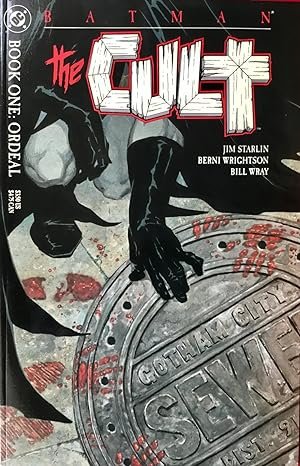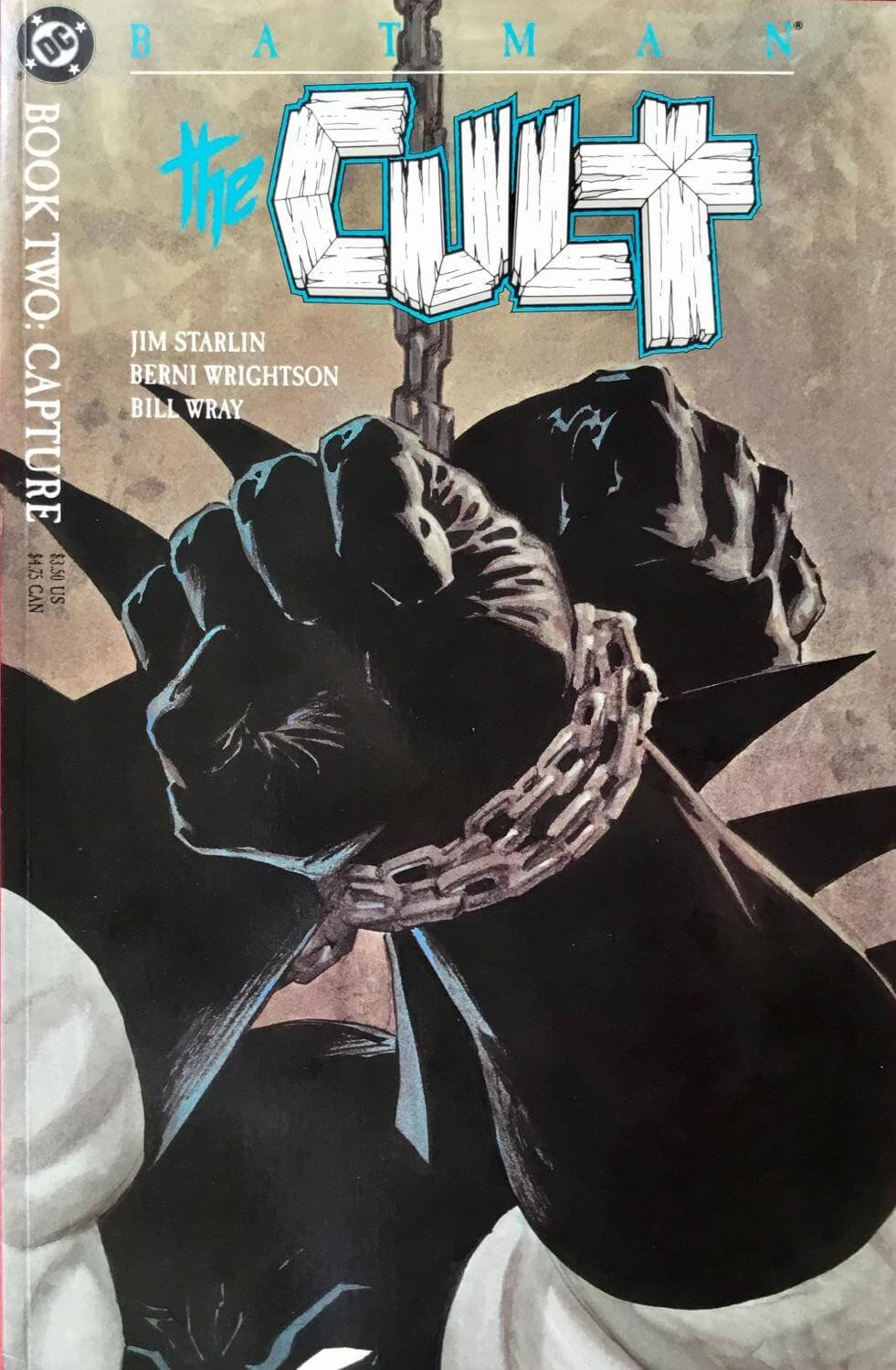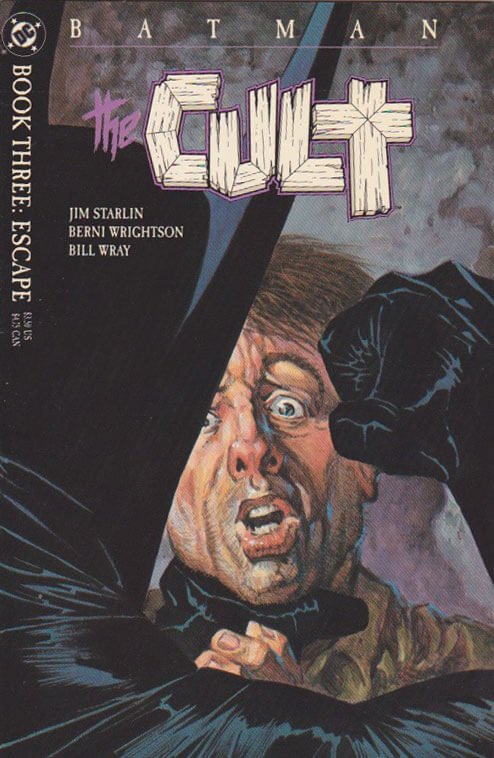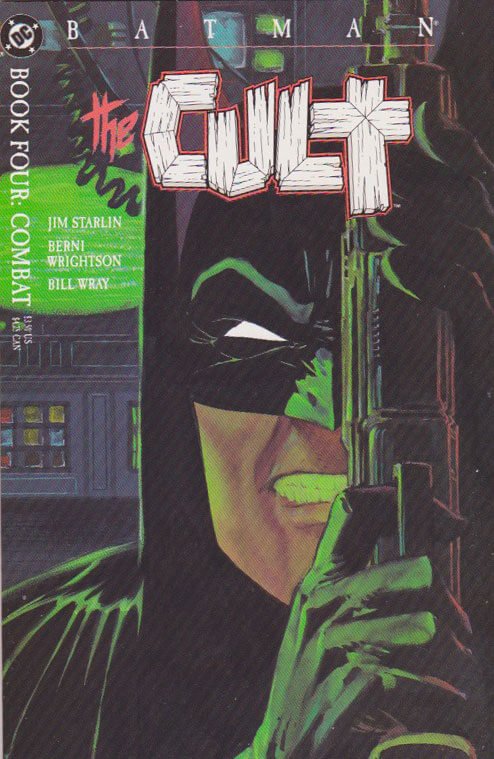Writer: Jim Starlin / Penciller: Berni Wrightson / Colour Artist: Bill Wray / Letterer: Jim Costanza / Collects Batman: The Cult #1-#4 / DC Comics
19th September 2020
The Pitch: Batman suddenly finds himself the prisoner of a mysterious religious cult led by Deacon Joseph Blackfire. But rather than eliminate the Caped Crusader, the cult attempts to break his will...and have him join their ranks!
Have you ever heard of this Batman book, The Cult? It came out about a year before Batman fever saturated the public consciousness, driven by the '89 Batman movie. It was a gorgeous, 4-issue prestige format back when ‘Prestige Format’ meant decent, cardstock covers, high-quality paper stock, and excellent printing. Plus the added bonus of that addictive-smelling binding glue DC used in their high-end books. Ah, the joys of being a comics stan in the '80s! I first discovered The Cult in a great little comic store that a friend introduced me to. We've all got that friend, haven't we? I mean, let's face it: if you were a male comics reader in the '80s, it was unlikely you were a hit with the opposite sex. Or the same sex for that matter. But we all had that friend. The one that took us to comic stores and got us hooked. Anyway, the store was Books, Bits & Bobs (sadly deceased) in Kingston. Kingston was a suburb of South West London and as such was easily reachable by train, so I was always allowed to go there at weekends. I was thirteen at the time and back then, at thirteen, you feared your parent's wrath. At least I did. It was a cool store. There I found The Killing Joke, Dean Motter's Prisoner sequel, and Starlin's Gilgamesh II. You'll note those were all Prestige Format books, too. It's that binding glue, I tell ya! But one weekend, it wasn't the binding glue that got my head swimming. It was the heady, intoxicating colours, art, and story in this Batman book I picked up. They had issue 2 in. Number 1 had sold out. And it would cost me the last of my pocket money. I bought it anyway. The cover had a glimpse of Batman's cowl. Above it, bound in chains, were his scalloped gloves. It looked good and tense. I'd never seen a logo like that on a comic before. This was going to be something special. Fast forward. If you did a poll today of a few thousand Bat-fans and asked them to give you the ten best bat books, you'd hear all the greatest hits. Killing Joke, Dark Knight Returns, Year One, A Death In The Family, Long Halloween... You get it. But would The Cult feature on that list? How many do you think would have read it? The answer is comparatively few. I was inspired to write about it after a brief Twitter exchange with a friend – funnily enough, the same friend who first introduced me to that comic store in Kingston. And would you believe me if I told you the ramifications of The Cult are still being felt in Batman lore today? It's true. But why? What's so special about this series? Apart from that binding glue?
Batman is broken and chained when the book starts, Starlin and Wrightson dare to keep him that way.
It's the colour that hits you first (at least if you picked up #2 before #1, as I did). I know, it's a tough call on a book drawn by the late, great Berni Wrightson to say the colours are the most striking, but we're talking first impressions here. Wrightson's art is laid on the trippy, marbled water-effect panels of Wray's colours. You're instantly in Batman's drug-fueled mind as he guns down a man he thinks is Two-Face. What's that? Oh, yeah... Batman kills in this. It's just the one guy that we know of but... he pulls the trigger. And he enjoys it. How did we get here? Well, that's another thing about The Cult. Starlin has the audacity to break the Bat. Before Knightfall, before Morrison. We don't get a confident, strong Batman. We find him at the start, broken, and chained. Being fed too little food and too many hallucinogens. He's a prisoner of the insane Deacon Blackfire, who has mobilised Gotham's homeless and turned them into an avenging army, murdering their way through Gotham's criminal element. And then the innocent folk for good measure. All whilst Batman stays in his drug funk, like Popeye Doyle in The French Connection II. What's amazing about the state we find Batman in is that Starlin and Wrightson keep him that way for three issues.
At first, Bruce refuses to take back Gotham.
It's a bold approach. Batman doesn't dominate the book. He becomes a cog in Blackfire’s machine. It was unusual at the time to see the lead character of a book like this. So weakened, he completely upended his philosophy. Blackfire accomplishes first by doing what the Batman didn't do – encourage and support the homeless of Gotham. It brings up interesting arguments. Is Batman's war on crime really a war on poverty since most crime is driven by that very same thing? Maybe, maybe not. But The Cult doesn't examine this too closely. Batman must escape the Deacon's clutches, which he does, only to find himself captured again by the Deacon's forces. It's a genuinely horrific loop to watch go around. Blackfire solidifies his hold on Gotham with a round of political assassinations, then starts going after the police. Things escalate as people panic. First, the National Guard tries to eliminate Blackfire... then the Army step in. And things get worse. The book is a wonderful study of the rising fear in cities. Anyone who has been part of a city as it rioted or as a protest got out of hand will feel a familiar unease rising in their stomach. As I write this, there are anti-mask protests happening in the centre of London. People armed with too much anger and too little information, compassion or understanding are massing. It's all too eerie. The Cult is about what happens when you take unfocused aggression and oppression and give it a direction and an enemy. It becomes more dangerous. It's actually refreshing to see a book take things as far as it does. Decimating Batman's mind to the point where, even after being rescued, he refuses to go back into Gotham and retake the city. It's a chilling moment, played out on the faces of Alfred and Jason Todd.
There’s eletion in seeing Batman take back Gotham, the real tragedy has already happened.
But all things must bend towards justice. Back in Batman and Robin must go and they do it with gusto. On a pure fanboy-destruction level, the Batmobile reveal – a monster truck with machine gun turrets and missile launchers – is a thing of joy. It's the rousing speech, the call to arms. The Batman is back and he means business! But although there is elation in seeing Batman try to take back Gotham, there's an underlying sadness. The tragedy has already happened. There's no turning back from it. The city can be rebuilt, the people repatriated to their homes... But the damage is done. The Bat has been broken. As a symbol of strength in Gotham, his time is over. What you see in The Cult's final issue isn't a triumphant ending. It's the beginning of an end. The end of Batman's indestructibility. You can draw a straight line from this to Knightfall, then to No Man's Land. What The Cult does is take the icons of Gotham and make them vulnerable. Human. Pliable. Breakable.
The downward spiral.
Starlin writes this downward spiral in a way that makes you feel it. You only get rare glimpses outside of Batman's experience of The Cult. The horror escalates even in these small moments, as the police attempt to dig into Blackfire's past and get an answer they can't comprehend. Starlin keeps the tension and the tragedy at all times, never letting up. There's no humour, no moments of levity. It just pushes and pushes, threatening to break not only the characters but the reader, too. Starlin was one of the best writers ever to take on The Bat – just look at Ten Nights of The Beast (or one from that all-time top ten, A Death in the Family). He got Batman where he lived and breathed. Wrightson's art is the kind that only superlatives can accurately describe. His work here is entirely apart from his brilliant Swamp Thing or Frankenstein Alive creations. Here he gives us both unreal – Batman's drug trips – and real. The faces of Gotham look lived in. They sag in all the places they really would, tired and worn. His action is exciting and scary. Everything looks tainted with blood – part of the hallucinogenic ride the creators are taking you on. The art, like the book itself, is a descent into despair. As mentioned, Wray's colours are glorious. His lighting is terrifying, illuminating everyone from below. The Deacon's light rises from the depths to swallow the characters. Completing the roll-call of '80s comics genius is John Costanza, whose lettering gives Batman's voice a broken croak of emotion and madness. The Cult's influence can be felt today. It was one of the books that changed the way we looked at Batman – now a character that was deeply flawed and all the more human. Prime fodder for men like Bane to break a few years later. Speaking of Bane, you can see the influence of The Cult on The Dark Knight Rises, in the speed and efficiency of Bane's message spreading and his hold on Gotham. Proof that at least some people read The Cult and loved it!
Buy the original series of The Cult right here, in our dedicated Batman Back Issue shop.









